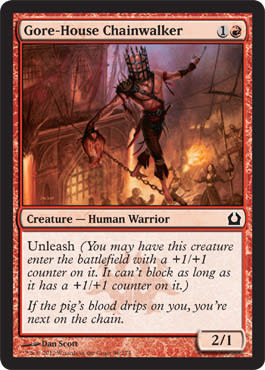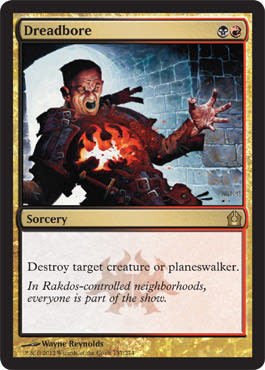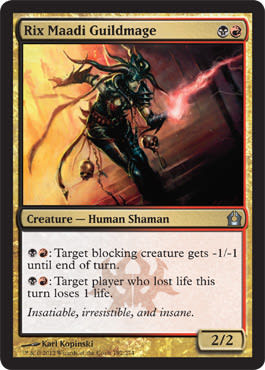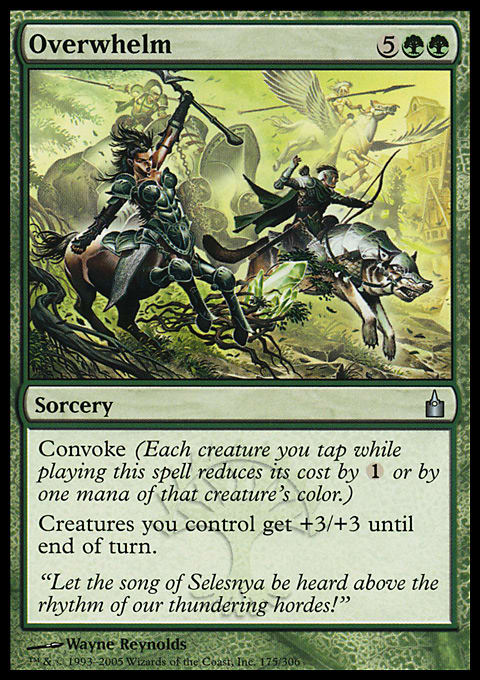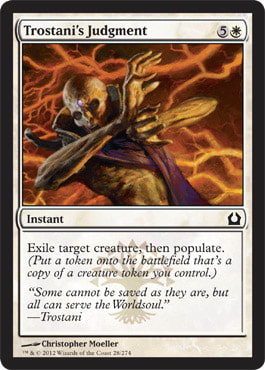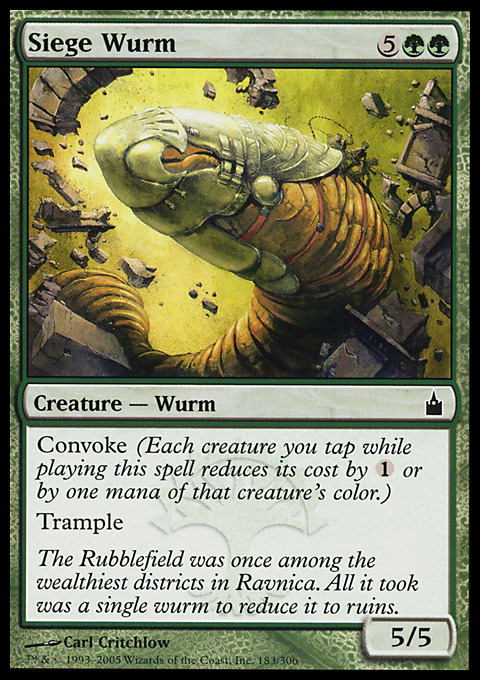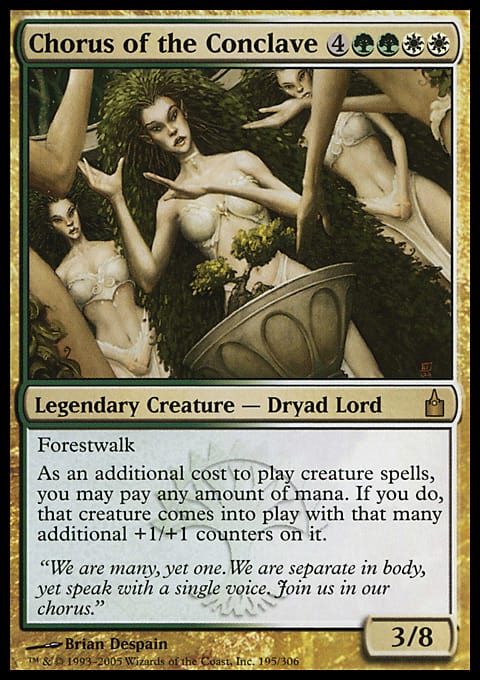And we’re back! If you haven’t already, check out yesterday’s article to see what we’re up to. Otherwise, I’ll assume you know what’s going on and jump right in.
Rakdos
Overall Flavor
A lot has already been said about this comparison, so I’ll attempt to be succinct. The Cult of Rakdos came across as too self-destructive the first time around. Not enough emphasis was put on the pleasurable aspects of their cruelty and self-destructive tendencies. I’ve still heard a few complaints, but I think Wizards got a lot closer to the mark this time around.
Mechanics
The keyword mechanics are a great example of Rakdos’s improvement. Hellbent, while a decent-sounding name, didn’t feel all that particular to Rakdos. Things become crazier when there are no cards in hand? I guess that means they’re not thinking, but do we have to stretch that far?
Unleash can give us the same flavor but without the stretching. They choose when to get out of control, and you don’t want to be around them when they do. This avoids the image of completely mindless beings—though there are still some of those around. It wouldn’t be Rakdos without them!
Card-by-Card
Blood Crypt and Blood Crypt – First, the art: The original’s composition is stronger, providing more than two planes of information, but I prefer the newer Blood Crypt. The pumped-up contrast feels much more Rakdos, and the hanging bodies are clearer. Second, the flavor text: I’m not sure what led Wizards to decide it was worth squeezing flavor text onto Ravnica’s shock lands, but boy do I love it! All five provide great insights into their respective guilds. I only hope Gatecrash’s five are just as good.

Havoc Festival and Anthem of Rakdos – The loss of life on Anthem makes no sense. Yes, the Rakdos will do things that hurt them, but why only on attack—and why is Anthem doing the damage? Havoc Festival fixes those problems and is cleaner to boot.
Rakdos, Lord of Riots and Rakdos the Defiler – Is this even a contest? Okay, the Defiler doesn’t care about his own troops when he attacks, but half seems a bit harsh for someone leading a guild. You don’t have a guild if you don’t have any followers. Lord of Riots on the other hand hits a Rakdos note well and acts like a lord. Done.
Rix Maadi Guildmage and Rakdos Guildmage – Rakdos Guildmage is a curious card. It almost feels as though Wizards wanted the card to feel Rakdos but became sidetracked along the way. His (its?) abilities fit, but they aren’t uniquely Rakdos. Rix Maadi Guildmage, on the other hand, has two abilities we don’t see all that often in Magic. Guess what? They both feel Rakdos! (Her second ability is a slight stretch depending on whom you ask.) Advantage Rix Maadi Guildmage.
Selesnya
Overall Flavor
Despite the original set holding over fifty percent1 more cards than Return to Ravnica, the newer set wins out. Perhaps it’s because there is a better understanding of the guild and its philosophies. Perhaps it’s because the flavor-writing talent has improved. Maybe it’s a bit of both.
The original set has five separate cards using the word “light” and another three or so calling out “faith” and “song” in their flavor text. A fifth of the cards—even more when you consider some do not have flavor text—give the impression of an organized religion. While Selesnya is second to only Orzhov in terms of religious entities on Ravnica, the original flavor gives the impression that little matters beyond “spreading the light.” I’m happy to see how much Selesnya’s message has improved in the new set.
Mechanics
This fight goes the other way: in favor of the original, convoke. MaRo stated in last week’s column that convoke was “the strongest design [of the original ten Ravnica guild mechanics] with the most potential for future use,” and that “it lines up beautifully with the philosophy of the guild, as green and white's overlap is very much about the value of community.”
So, what’s wrong with populate? Nothing really. It once again shows Selesnya’s love of the community and the desire to help living things flourish. What it lacks, however, is the depth convoke conveys. Convoke not only shows the importance of propagation, but how entities work together to progress the community. In short, populate is too one-dimensional.
Card-by-Card
Armada Wurm and Autochthon Wurm – I know autochthon is a real word, but I strongly dislike the clash of how I initially perceived it to be pronounced and its actual pronunciation. (Hint: aw-tok-thuhn) Thank you, Greek. While both flavor text bits give a great image, Armada Wurm’s is simple, sweet, and tells us something about the guild and the card. Round 1 goes to Armada Wurm.
Side note: For those of you out there snickering about Armada Wurm's art, I recommend taking a look at Siege Wurm before falling into the gutter.2 They are wurms. With armor. That need to dig through dirt. Grow up and deal with it.
Centaur Healer/Call of the Conclave and Centaur Safeguard – Healer is just a better Safeguard—with modern power taken into account. Why would a Guardian give you life when it dies? Its dying means you’re once again vulnerable. Again, we have better flavor text on the newer card(s). Call tells us centaurs are strong and warrior-like while also telling us something about the Conclave. Centaur Safeguard merely gives us a look at centaurs.
Common Bond and Seeds of Strength – These two are much closer than our previous two examples. Flavor texts for both describe some aspect of Selesnyan life well. However, changing the card’s mechanic from temporary to permanent and adding the word “bond” to the name makes Common Bond a hit while Seeds of Strength must be satisfied with simply being good. It’s about connection, people.
Trostani, Selesnya's Voice and Chorus of the Conclave – I believe Chorus to be the better-designed card in a vacuum. Its abilities clearly show what Selesnyans’ chants can do for them. As a focal point for the guild, however, Trostani is the clear winner, emulating the guild’s values well.
Vitu-Ghazi Guildmage and Selesnya Guildmage – Understanding the fact that guild mages in the original Ravnica were not given flavor text, these guys go toe-to-toe no matter how long the fight.
The Unguilded
Return to Ravnica approaches the guildless openly. There is no one theme or philosophy tying them all together. Instead, we have been given cards that show the plane’s creatures (Aquus Steed), daily life (Bazaar Krovod), or the general population’s feelings about the guilds (Fencing Ace). It provides an opportunity to see what life on Ravnica is like for those not associated with a guild.
The original sets provided opportunities to learn these stories as well, but there was also a subplot spread across a few cards—that of the Nephilim. Is a subplot about a group unrelated to the guilds a good thing? Does it make the story richer? Does it cause focus to be lost on the guilds? I don’t have the answers for you, but it seems Wizards has avoided those questions this time around—at least until Gatecrash.
So, how was the review? Did you prefer it to only looking at the new set? Or would you have rather I had spent more time on the new cards? As always, let me know what you thought, and feel free to voice your own opinions on which set did things better. See you next week!
1 The original set has forty-two cards with the Selesnya watermark. Return to Ravnica has twenty-six. While Selesnya has the largest disparity, the disparity in general is due to large sets now being smaller and Return to Ravnica’s accommodating five guilds instead of Ravnica: City of Guilds’s four.
2 I don’t have the room here—nor do I want to take away from the focus of this review—to dissect why Armada Wurm’s art is a huge upgrade. For now, know that it is.
















